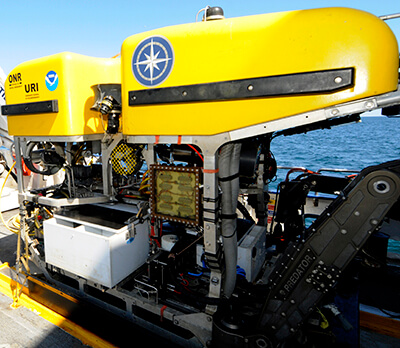Deep-Sea Coral

Deep-sea habitats in sanctuaries off the West Coast are home to a diverse array of deep-sea corals, sponges, and other habitat-forming invertebrates. Occurring at depths beyond the reach of sunlight in cold water, deep-sea corals and sponges primarily rely on filter-feeding for food. Although extremely slow-growing, these long-lived invertebrates form complex 3D structures that provide a number of important ecosystem services. For example, deep-sea corals and sponges are considered essential fish habitat, or habitat required for the growth, reproduction, and survival of fish and other marine organisms.
Several species targeted in the West Coast commercial groundfish fishery, such as rockfish, sablefish, flatfish, and Pacific whiting, are often associated with deep-sea corals and sponges. In some cases, this can unintentionally lead to habitat damage when bottom-type fishing gears contact corals and sponges, threatening their long-term persistence. Other threats include impacts from marine debris, submarine cables, offshore energy development, oil/gas exploration and extraction, dredging, and changing environmental conditions.

There is still much to learn about deep-sea habitats off the West Coast as less than half of the ocean and coastal waters of the United States have been mapped, and even less have been observed using camera systems such as remotely operated vehicles (ROV). Images of the seafloor provide valuable information used to validate mapping data and to document where deep-sea corals and sponges occur. When coupled with environmental observations (such as temperature, current speeds, pH, etc.), mapping data help scientists understand the conditions that deep-sea corals and sponges need to reproduce and survive, and how those conditions might be changing both naturally and due to anthropogenic factors.
To address this gap, NOAA established the Deep Sea Coral Research and Technology Program (DSCRTP). The program supports collaborative, multi-year regional research initiatives and curates information into a comprehensive and publicly accessible database. For more information on DSCRTP's West Coast efforts and how national marine sanctuaries are involved, see the West Coast Deep Sea Coral Initiative's Science Plan. In addition to being an active partner during program-supported initiatives, Channel Islands National Marine Sanctuary has also collaborated with National Marine Fisheries Service, National Centers for Coastal Ocean Science, Marine Applied Research and Exploration, and the Deep Sea Ecology Lab at the University of Charleston to conduct quantitative deep-sea research within the sanctuary. These partnerships have led to discoveries of dense coral gardens and new species within sanctuary waters as well as generated data on the status and trends of this habitat type for synthesis into sanctuary condition reports.

